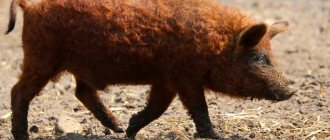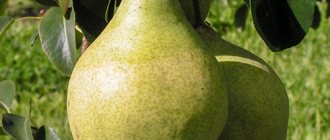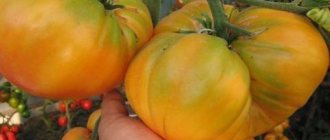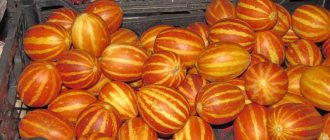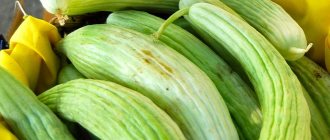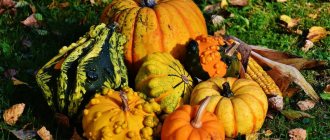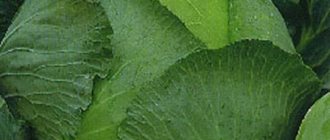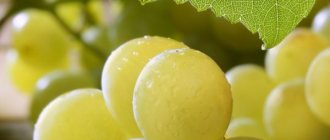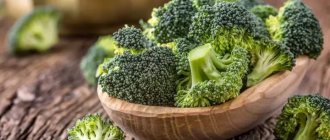Columnar pear is a unique tree that does not grow like a classic tree in all directions, but only in height.
Nowadays, many crops have been developed that are adapted to different climatic zones and have different taste characteristics. A columnar variety of pear was bred relatively recently in 1998 by breeder M.V. Kachalkin, in the Tula region. The variety was bred in parallel with the columnar apple tree, although the creator himself preferred to call the pears super-dwarf.
In fact, trees differ from traditional ones in crown shape, growth and increased productivity. The latter plays a big role when choosing this type of pear.
Features of columnar pears
The most important feature of the columnar pear is its compactness. The branches do not spread out to the sides, but are pressed tightly against the trunk; the fruits are formed directly near the base.
The yield of columnar trees is several times higher than that of classic pears, and there is much less maintenance.
Many people mistakenly assume that a tree has no branches, but this is not true. In the process of genetic changes, they have become smaller and are adjacent to the trunk. The fruits are attached by their stalks to the base of the knots, thereby creating the effect of clinging to the tree.
When do they begin to bear fruit?
Columnar pears, like columnar apple trees, begin to bear fruit in the second year. Their yield is abundant and has not decreased for several years. Each growing season, plants can produce from 2.5 to 3.5 kg per unit. For a compact tree these are very good indicators.
Fruiting continues for 10-15 years, then it declines and stops completely. By this period, it is worth taking care of planting new specimens, and leaving the old ones as a decorative decoration for the garden.
It is best to harvest the first harvest slightly unripe to allow the tree to regain its strength.
How do they reproduce?
Since the columnar pear is a selective crop, it is very difficult to propagate by seeds.
Farmers prefer to buy new seedlings bred in two popular ways:
- vaccination;
- cuttings.
Seeds
It is possible to propagate the columnar pear from seeds, but breeders do not recommend it.
The process is complex, painstaking and takes a lot of time. Sometimes it takes more than 2 years to grow a seedling, and it is also possible to breed several specific varieties in this way. On the other hand, the resulting trees have natural, non-mutated parental genes.
Vaccinations
The most common scion for dwarf pear is quince, serviceberry. It is carried out in mid-spring, when the growing season has already started, and frosts and sudden temperature changes have passed. This is necessary for better adaptation of the vaccine, therefore in the middle zone they are vaccinated only at the end of April - the second half of May. There are conditions that must be observed when grafting:
- The time of day is either early morning or late evening. If the weather is cloudy, then you can do it during the day.
- Harvesting cuttings begins in winter and is stored in a dry, cool place.
- The instruments are prepared clean and, if necessary, further sharpened. The sharper the knife, the more precise the movement, and the less damage to the tree.
- The length of the scion should not exceed 80 cm, but should not be significantly lower than 70 cm.
- The grafting site is bandaged with electrical tape and sealed with garden broth.
Vaccinations are done in three ways:
- lifting the bark;
- making a side cut;
- into cleft
The survival period of the cuttings is up to 1 month.
Cuttings
Cuttings are prepared in advance, choosing one- or two-year-olds with 2-3 internodes and a height of no more than 30 cm. Then the cuttings are placed in a root solution for 48 hours. For better formation of the root system, the bottom is cleaned.
When the first tubercles appear on the trunk, the cuttings are dug into the ground and covered with polyethylene. Many gardeners mix the soil with peat or sphagnum to provide the maximum amount of nutrients.
In this way, trees take root quickly, within 2-3 weeks.
Reproduction
The ideal option for propagating columnar pears is to plant ready-made seedlings. Pears can also be grown from seeds or by cuttings. Seed propagation is not very popular. It will take a long time before the seedling grows, and even after that it will need a rootstock.
Many varieties of common pears are propagated by cuttings. Columnar pears are no exception. Only green cuttings are suitable for this method.
Columnar pear seedling
- First, the cuttings are cut. They must have at least four leaves and two internodes.
- The cuttings are kept in a root-forming solution for several days.
- The cuttings are buried in soil consisting of a small layer of sphagnum and sand.
- If the cutting takes root, it will begin to grow very quickly.
Attention! The simplest and easiest way to propagate columnar pears is grafting. According to reviews from gardeners, it can be noted that the growth of established branches is higher than with other propagation options
And the rootstock can be an ordinary pear or shadberry.
Varieties
Like ordinary, classic trees, columnar pears come in different varieties:
- ripening in early autumn;
- summer-autumn options;
- autumn;
- autumn-winter;
- winter.
Of course, each type differs not only in the weight of the fruit, but also in taste. For example, pears that ripen in early autumn have a rich aroma, bright yellow color and juicy flesh. The weight of the fruit can reach up to 400 grams.
Late-ripening, autumn pears have an orange side, skin, as if covered with oil, and the weight is 2 times less than early-ripening ones.
Very winter varieties reach 150-200 grams, the pulp is dense, but aromatic with a slight honey tint. They are also characterized by small spots on the skin.
Pears that ripen early are looser and are not capable of storing for a long time; winter varieties are elastic, dry and are sometimes stored until spring.
Gardeners identify several of the most popular varieties.
Decor
The Decorah pear is small and classified as semi-dwarf, its maximum height is 2.2 meters. In addition, the variety has the following species characteristics:
- It is unpretentious to the composition of the soil, resistant to infections and viruses, and also frost-resistant.
- The pear begins to bear fruit 2 years after planting in its main place.
- The fruits of the columnar pear have a sweet-sour taste and are very juicy. They are compared to the scent of a rose.
- The shape of the fruit is oval, its weight ranges from 200-230 grams. At the same time, the skin is quite thin, so the fruits are not a shelf-stable variety.
- The color is intense yellow.
It is important to note that this is a late-ripening variety, so it is not recommended to plant the tree in northern latitudes. There are other pear varieties for Siberia that are recommended for cultivation.
Sapphira
Sapphira is a variety that ripens in mid-autumn. Pear picking begins in the first half of September and ends in early October, before the first frost.
- Fruiting of the Sapphira variety begins in the 3rd year after transplantation;
- fruit weight up to 200-250 grams;
- shape , widening towards the bottom;
- color is yellow with a green tint and small dark brown spots;
- frost resistance is relatively good;
- The tree is also immune to scab.
Gardeners determine the readiness of fruits for harvesting by the appearance of a red blush on the pear.
Delight
The Delight variety is a relatively new variety of columnar pear, ideal for the middle zone, the Moscow region. Breeders bred it with relative resistance to frost, but at the same time with a rapid ripening stage.
Already at the end of July, the first fruits are collected from the tree. Their taste is bright, juicy with a slight honey tint and slight sourness. The weight of the fruit is about 150 grams and is elongated.
Carmen
Carmen, like Delight, is a summer variety. A characteristic feature of the variety is the burgundy color of the fruits, weighing up to 300 grams. Thanks to these qualities, the pear is incredibly popular among gardeners; entire orchards of 1.4-2000 specimens are formed from the trees.
In terms of taste, pears are classified as dessert fruits; the fruit is juicy, sickly sweet with a thin skin. The first harvest ripens in early June, and the first fruiting after planting is possible in the second year.
Carmen is also used for landscape design, since the pear has a bright and textured appearance, both during the fruiting and flowering seasons.
Description, origin
Thanks to M.V. Kachalkin, gardeners are growing miniature fruit trees. The breeder endowed the columnar pear with short stature and productivity, frost resistance, and unpretentiousness. The taste of the fruits of such a tree exceeds expectations - the delicate honey pulp is rich in juice, and the aroma will amaze even experienced gardeners.
“The columnar pear is grown from seeds, with obligatory subsequent grafting onto a frost-resistant rootstock - quince or shadberry. If the seedling is not grafted, it will grow wild.”
The height of the tree does not exceed 1.5-2 m. The dwarf's trunk is strong and developed. The lateral branches are located along the entire length of the trunk. After planting, the tree blooms within 1-2 years. If you properly care for the crop, the first harvest will be 1-3 kg of fruit. The attractive appearance of the tree has found application in landscape design.
Dwarfs easily take root, are undemanding to living conditions, and the variety of varieties allows you to choose a columnar pear for the Moscow region, Siberia, and southern regions.
Advantages and disadvantages
Let's consider the pros and cons of keeping a columnar tree on the site. The advantages of culture include:
- compact dimensions. The pear is so compact that it does not require much space. This growth makes it easier to care for the crown and harvest;
- high resistance to adverse environmental factors. Columnar pear is winter-hardy, resistant to exhaust gases and dust;
- productivity. Hybrids produce 3-15 kg of fruit;
- unpretentiousness. Cultivars grow even in heavy soils with low organic matter content. Caring for a columnar pear will not cause much trouble for the gardener;
- resistance to diseases. Breeders have endowed hybrids with immunity to scab and fungal diseases;
- decorative qualities. Landscape designers recommend planting columnar pear varieties to decorate a summer cottage;
- easy survival. This amazing tree easily tolerates the planting process and quickly begins to grow;
- assortment of varieties. Although the culture is still young, many hybrids have already been bred for cultivation in different regions - there are varieties for the Moscow region, Leningrad region, Central Russia, the Urals, and the North;
- precociousness. Having planted a crop, the first harvest is harvested the following season;
- different periods of ripening and storage of fruits. A plus for summer residents who dream of storing their crops for a long time;
- large aromatic fruits. One-dimensional fruits with excellent taste characteristics ripen on low plants.
The disadvantages of the culture include a short lifespan; the description says that it is 10-15 years. Throughout the entire fruiting period, the tree requires constant care, including proper pruning, abundant irrigation and annual fertilizing.
Advantages and disadvantages of trees
Columnar pears are grown in farm gardens for many reasons:
- The trees take up little space, but bear fruit already in 2-3 years and very intensively.
- In addition to good yield, pears provide an aesthetic appearance.
- Due to their compactness, without spreading branches, gardeners plant them more densely, which further increases the yield.
- Plants take root quickly and almost painlessly.
- The fruits of early varieties are large and reach 300 grams, while the low growth of trees up to 2.5 meters helps to quickly harvest the fruit.
- The pear is unpretentious to the soil and is frost-resistant.
- The fruits are used both raw and for various preservations, jams and compotes.
There are only two disadvantages of the columnar type pear:
- The maximum fruiting period is no more than 15 years, and in some types up to 10 years.
- The range of varieties is not very large.
Severyanka
Early summer high-yielding variety of pears. The tree is low growing. The fruits are blunt-conical in shape, yellowish-green in color. The pulp is fine-grained, dense, juicy, with a sweet and sour taste. The fruits are suitable for canning and fresh consumption. The variety is affected by scab.
| Entry into fruiting | Tree height (m) | Fruit weight (g) | Harvest | Shelf life (days) |
| At 5-6 | 1,5-2 | 70 | Second half of August | 7-10 |
Columnar pears produce a good harvest, and every year, this is a definite plus for growing them. But, unfortunately, their fruiting period is short, as a rule, 7-10 years, after which something new will have to be planted. However, columnar pears produce a harvest every year.
***
It is especially noteworthy that, in terms of tons, the yield of columnar pears is several times higher than that of ordinary trees, and they take up less space on the site. In any case, you choose which fruit trees to plant in your garden.
Features of cultivation
The root system of columnar pears develops in a horizontal plane and is located near the surface.
Due to the peculiarity of their structure, trees are planted in the spring, thereby minimizing the risk of extinction and the adaptation period. The soil for seedlings is prepared 2-3 weeks before the expected date:
- a hole is dug about half a meter deep and about 60 cm in diameter;
- the distance between rows is 1 meter.
Preparing the soil and pit
The soil for the planting hole consists of:
- humus;
- compost;
- natural earth;
- organic fertilizers.
On average, 3-4 kg of soil and 1 bucket of settled water are calculated per tree.
Distance between trees
Despite the fact that columnar pears do not have lateral shoots and are compact in size, gardeners recommend maintaining certain distances between trees. Row spacing should be at least 1-1.25 m;
the distance in the row is from 40 to 50 cm. Smaller sizes can lead to a lack of air and light, which will directly affect the amount of harvest, as well as the spread of diseases.
In close proximity, scab can be transmitted from one tree to another with lightning speed.
Features of the root system
As noted above, the root system of the columnar pear is poorly developed; the shoots spread horizontally without going deep into the ground. On the one hand, this is a plus for adaptation, since the top layer has more nutrients and is warmer.
On the other hand, the shallow root system does not tolerate frost well and adapts less well when planting in the autumn.
Selection of seedlings
To have a healthy garden with a bountiful harvest, gardeners adhere to several rules when choosing planting material:
- Trees are taken as one- or two-year-olds.
- The seedling must have all the necessary documents, as well as recommendations for care.
- A healthy pear has green, juicy bark and leaves.
Older seedlings can be carriers of various infectious diseases.
Landing rules
After the soil has been prepared and a hole has been dug, planting begins. The pit is moistened generously with water and allowed to soak. Then the seedling is placed vertically, with the root system straightened.
To ensure that the root system expands as much as possible and does not bunch up during the digging process, pegs are driven between them.
They try to leave the grafting site above the surface of the earth, and cover the entire root system.
The soil is filled in two stages:
- filling half the pit;
- neat compaction;
- remaining land.
After completing the procedure, the seedling is watered again and soil is added to the failed areas.
How to choose a seedling and place for planting
Planting a columnar pear must be preceded by the correct selection of seedlings and growing space.
The seedlings are purchased from a nursery with a good reputation. You should not buy planting material from hand or from unverified companies - in this case, there is a risk of getting a diseased tree or a pear of the wrong variety.
At the time of purchase, consult with the seller about the type of tree and how to care for this variety. Remember that the variety of columnar pear must suit the climatic conditions of your region, as well as the requirements of the soil and the size of the garden plot.
During the purchase, you will be asked to dig the seedling out of the ground so that you can examine its root system. At this point, it is important to carefully examine the entire rhizome for parasites, signs of rot or other diseases. In addition, pay attention to the entire trunk: if you pry up the bark of the tree with your fingernail, you should find a green and fresh surface. The seedling should not have leaves, dry shoots or rotten branches.
Purchase annual seedlings of columnar pears, since older planting material does not take root well in a new location.
The next step should be to determine where to plant the pear tree and how to prepare the soil for planting.
According to farmers, dwarf pear varieties are undemanding both in terms of planting site and soil. However, due to its miniature size, it is not recommended to plant pears in very windy places, since powerful gusts of wind can break or knock down a young tree. For the northwestern regions, it is recommended to choose the most illuminated place on the site; in the south, the pear can be slightly shaded. It is also important to remember about the danger of close groundwater, which can lead to rotting of the rhizome.
This variety of pear trees can withstand almost any soil, even clayey ones. But the soil must be nutritious, with an average content of hydrogen ions. To prepare the soil, it should be weeded in the fall and humus should be added to the ground. If the acidity is high, then wood ash is added to the soil.
Care
Columnar pears are unpretentious in care; only basic actions typical for an orchard are carried out on them:
- pruning;
- feeding;
- loosening;
- preparatory work for cold weather;
- protection from pests and weeds;
- watering.
Regular fulfillment of all conditions ensures a full and rich harvest of pears.
Feeding
Fertilizing is an important stage in the development of a tree, especially if it is grown on ash soil or in conditions with little daylight and a relatively short summer period.
All fertilizers are applied in the active stage of the growing season - in spring and summer. Particular attention is paid to young plantings; they are fed with slurry or chicken droppings. Plantings can also be fertilized with saltpeter and urea.
Fertilizers are never used in pure form; they are diluted with water in a ratio of 1 to 7 or 10.
The first feeding is carried out as soon as the first leaves bloom; the second – after 2 weeks, the next after another 2 weeks.
Do not forget about watering the row spacing, in particular at a distance of more than 2 meters.
Trimming
The formation of the crown and the growth of the pear itself depend on the correct pruning of the plant.
The essence of the procedure is to remove excess, while giving stronger nutrition to the remaining elements of the tree.
The trunk itself is not cut, but only the side shoots. It happens that a pear slows down its development, then it is cut off, leaving a cutting of 2-3 buds. This results in natural growth stimulation.
It should be remembered that in the first year the flowering of the tree is stopped by plucking out all the flowers.
Reviews from gardeners
Most gardeners admire columnar pear varieties, claiming that they have more positive than negative qualities.
Evgeniya, 45 years old, amateur gardener. My husband and I once went to a fair, where two seedlings of a columnar pear caught our eye. The seller assured that the harvest was good, the fruits were juicy and large. They planted it on the site, regularly watered it and applied fertilizer. Within a year, the tree began to bloom, and in the second year after planting, fruits appeared.
But we didn’t ask the seller how to properly care for the pear tree... we trimmed it as best we could, so the trees became branchy. Then some pests attacked - the trees became sick and died. Having learned from bitter experience, we read a lot of literature before purchasing new seedlings. Now we annually harvest a good harvest, properly care for and treat the trees against diseases and pests.
Alexander, 58 years old, experienced gardener. For many years now I have been growing columnar pears in my summer cottage. I have several varieties, but I still like Sapphira. I like the juiciness and excellent taste of the fruit. With proper care, including fertilizing, pruning, and insulation before winter, trees will annually delight you with a large harvest, beautiful and tasty pears.
Artem, 38 years old, a beginner gardener. An acquaintance highly praised the columnar pear tree growing on his property. I myself live in a private house, so I decided to buy seedlings. I fertilized the plant and watered it regularly. In the first year I plucked all the inflorescences and wrapped them in burlap in winter. Now my trees are three years old, I am harvesting a good harvest for the second season. The fruits are tasty, juicy, and all friends and family like them.
Hide
Add your review
Today there are not many varieties of columnar pear, but those that exist have already gained popularity among many gardeners. The plants are unpretentious in care, but require proper pruning and regular fertilizing, which especially affects growth and development, as well as fruit ripening and yield.
Disease Prevention
To prevent diseases from spreading to columnar pears, plants are planted around them to repel insect pests. Such herbs include: tobacco, lemon balm, mint and other strong-smelling varieties.
Also, to protect against moss and lichen, the trunk is whitened, approximately 1 meter from the ground.
Be sure to monitor the dryness of the soil, preventing it from becoming waterlogged.
At the first manifestations of rust and scab, the affected branches are cut off, the foliage is burned, and the planting itself and nearby trees are treated with a solution of urea or sulfur. In more serious cases, chemical control options are used.
Spraying
Pear trees have delicate leaves that suffer from excessive dryness, so spraying is an important and daily care procedure. The mistake of novice gardeners is that they begin to irrigate trees on hot days, although the first manipulations are carried out a few days after the snow melts.
As soon as it becomes clear that the thermometer has clearly established itself at +5°C during the day, the seedlings are sprayed, thereby hardening them and protecting them from pathogenic microbes.
Copper or iron sulfate and urea are added to the solution in the spring. For preventive purposes, the substances are diluted in a proportion of 50 g per 10 liters of water.
Characteristics of columnar pear fruits
Depending on the timing of fruit ripening, pears differ in taste, juiciness and size.
The largest varieties, up to 300 grams, ripen in the summer. They are distinguished by juicier pulp and thin skin. Such pears are amber-yellow in color, sometimes with small inclusions. The varieties are sweet, but absolutely not shelf-stable.
Winter varieties are also sweet, but the taste is sour, the flesh is denser, the skin is tight and has an oily surface. They are smaller, weighing up to 150-200 grams, but have high frost resistance and shelf life.
Description
Until the sixties of the last century, gardens with trees grew for several decades. So the McIntosh apple tree in Canada grew like this for about fifty years. Variety as a variety. Yes, and the tree is ordinary. Except for one branch. Not like everyone else. And stands out from the rest:
- Thickened.
- Entirely covered with foliage with fruits, also densely, next to each other, located on the branch.
- There were no side branches.
- And this natural mutation was just what breeders around the world were waiting for. She turned out to be capable of reproduction. And this is due to the presence of the Co gene.
- In 1976, the first sample was named Vazhak. And a little time has passed, but more than 100 varieties have already been bred.
What is a columnar apple tree:
- Seedling. A one-year-old columnar apple tree cannot be confused with a seedling of an ordinary apple tree: In terms of the thickness of the trunk, it is much more solid and thicker.
- The height is about a meter.
- Along densely located foliage and buds.
- According to the root system - located very close to the surface.
- The trunk is much thicker and more powerful than the branches.
Important! Instead of many branches, there are fruitlets, ringlets and spears on the trunk. On strong shoots the internodes are shortened. The shape is compared to a pyramidal poplar
And they call it columnar
The shape has been compared to a pyramidal poplar. And they call it columnar.
How has she gained such popularity, attention and love from everyone who has something to do with apples? I have no doubt
These characteristics will also attract you:
Columnar apple tree at different times of the year.
- Amazing compactness - where one Antonovka grows, you can plant up to 20 columns.
- Decorative. Not just apples. But the columns of apple trees are also surprising.
- Productivity is high.
- Large assortment with high resistance to disease and frost. A find for regions with harsh climates.
- Precociousness. Almost from the second year you begin to taste your apples.
- Not care, but pleasure. No need for long pruning shears or extended sprayers. And ladders for harvesting
- If only they were cheaper. But this does not stop amateur gardeners. No farmers.
Preparing for winter
Preparations for winter begin at the moment when the entire harvest is harvested and all the leaves have fallen from the trunk and branches. Fallen leaves are collected along with garbage and burned.
If you don’t do this, you can create excellent soil for the proliferation of pests that usually overwinter in humus.
The weak point of columnar pears is the top. In the first 2-4 years, it is very tender and needs to be covered with fabric that protects it from frost, but at the same time allows air to pass through.
The bottom of the pear is tied with spruce branches and sprinkled with snow, thereby protecting it from rodents and hares.
Reproduction
The best and easiest option to propagate a columnar pear is considered to be planting ready-made seedlings. You can also grow from seeds or by cuttings. Seeds are used quite rarely, since the method requires a lot of time.
Green cuttings are required for cuttings.
- Initially, cuttings are cut off. They must have more than five sheets.
- For a couple of days, the cuttings are soaked in a root-forming solution.
- The cuttings are sprinkled with soil.
- If it has taken root, it will grow quickly.
A very popular and easy method of propagating pears is grafting. Gardeners comment that the tree grows much better in this way than in other ways. The rootstock can be an ordinary pear.
All columnar pear fruits have a special taste and delicate aroma. They can be stored for a long time, and the tree itself is not afraid of frost. If you provide pears with the care they need, you can reap a good harvest as a result. In addition to practical properties, columnar pears can be an excellent addition to the design, for example, serve as a hedge or an original decoration.
Advice from gardeners
Experienced gardeners also give advice on how to remove the maximum number of fruits from a columnar pear:
- In the first year, all flowers are removed from the pear, allowing it to gain strength for fruiting in the second year.
- In subsequent years , care is taken to ensure that the tree has enough nutrition for full development.
- The pear variety is selected relative to the growing region, so winter-hardy varieties are purchased for the middle zone.

